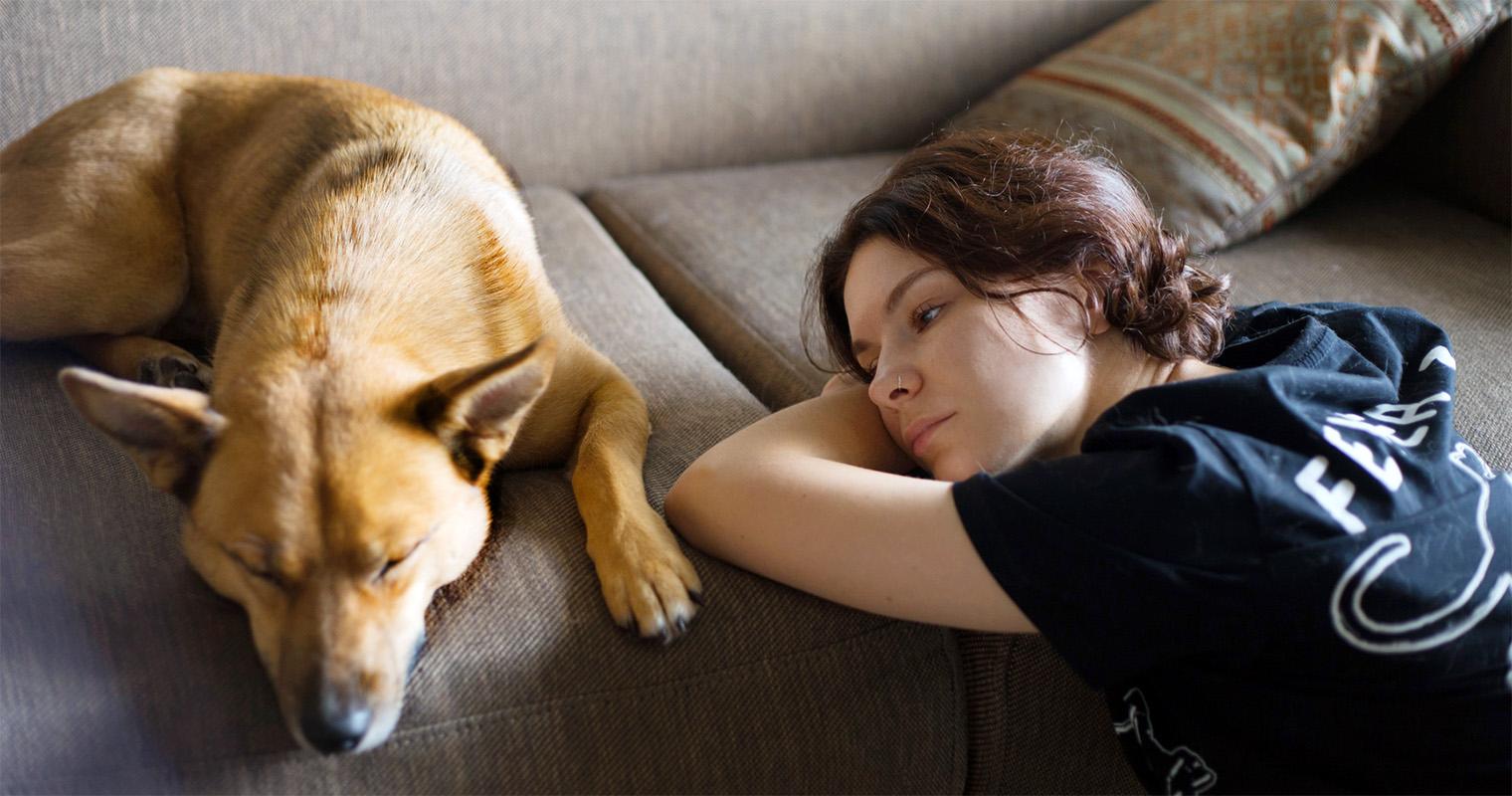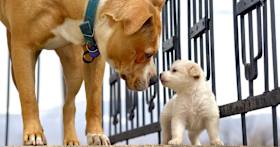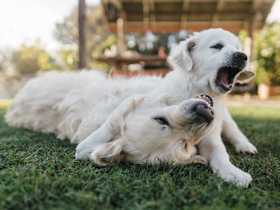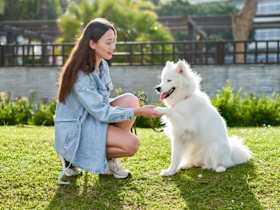The 3-3-3 Rule For Dogs: Rescue Dog Adjustment Period Explained
Find out how to set your adopted rescue dog up for success.
Find out how to set your adopted rescue dog up for success.
by Katie Koschalk, | October 16, 2025

Demetr White / Stocksy
Bringing a new dog into your home can throw even the most meticulous planner for a loop. Your new family member might keep a cautious distance, eyeing you with uncertainty from across the room. They may refuse to eat, and you’ll likely have to clean up an accident (or 25). OK, now you might be wondering if this is how things will always be. In the first three days, weeks, and months post-adoption, your new dog is likely to progress through distinct phases, often referred to as the 3-3-3 rule for dogs.
Here’s the good news: This kind of behavior is normal and typically a temporary part of the adjustment process. Understanding these phases and learning how to provide the best support during each can help your newly adopted dog find their groove in their new digs.
The 3-3-3 rule is a guideline for helping newly adopted dogs acclimate to their new homes. It provides recommendations for the dog’s first three days, three weeks, and three months after adoption. Here’s how it breaks down: Start by giving your dog at least three days to decompress, followed by a three-week period to establish routines and introduce basic training. The final phase — spanning three months — focuses on gradually exposing the dog to various environments and experiences, allowing for a smoother adjustment and building a positive relationship.

New rescue dog? Don’t panic — here’s your survival guide for the first few days and how to connect with your new best friend.
It generally takes around three months for a newly adopted dog to feel truly comfortable in their new home — but it may take shorter or longer depending on your rescue dog’s age, background, and temperament. Here’s a simple guide on how to help your dog adjust to their new home by applying the 3-3-3 rule.
The first three days in a new home can be very overwhelming for your dog — and every dog will react differently. Some may exhibit signs of fear and withdrawal, while others might pace or eagerly investigate every nook and cranny of your house. Your new pup might also have accidents, even if they’re already house-trained.
This is all normal behavior for a dog suddenly thrust into a new environment with unfamiliar people and scents, so try not to panic. These first few days are not a reflection of how your dog will behave forever.
Think of your new dog’s first three days as their time to decompress. Here’s how to care for and respond to your dog during this phase:
Limit interaction: While you’ll likely want to immediately shower your new dog with affection, it’s important to allow them to settle in without overwhelming them with too much attention. Giving them space to explore their new surroundings at their own pace will help avoid overstimulation and allow them to feel more in control. (But if your pup actively seeks your attention, then by all means, give them some love!)
Keep things quiet: Avoid hosting gatherings or exposing your dog to loud noises and commotion that could overwhelm them.
Provide a cozy space: Provide your dog with a comfortable space of their own, like their own bed with a cozy blanket and plush toy.
Introduce them to a routine: Start a simple daily routine for feeding, bathroom breaks, and short walks around your home. Predictability and consistency can help them feel secure and understand what to expect.
The second phase of the 3-3-3 rule extends over three weeks. During this time, your new dog is likely to gradually settle in and grow more comfortable. You may notice them starting to let their guard down and reveal glimpses of their true personality.
But, most dogs will still feel some uncertainty about their new environment and daily routine, which can manifest as occasional anxiety or restlessness. It’s also not uncommon for a new dog to start testing boundaries, like a teenager seeing what they can get away with.
The focus of these three weeks should be on establishing a routine, introducing basic training, and deepening your bond with your new canine companion. Here’s how to navigate this crucial period:
Build a solid routine: Continue to reinforce a daily routine for feeding, bathroom breaks, and exercise. Consistency is key, as it helps your dog feel more secure and confident in their new home.
Teach basic training: Begin teaching your dog their name and basic commands like “sit,” “stay,” and “come.” Use positive reinforcement by giving your dog a treat and praise when they’re successful. Keep training sessions short and engaging to maintain your dog’s interest and motivation.
Begin socialization: Slowly introduce your dog to other pets and people in your home, but do so in a controlled manner.
Provide consistent feedback: Give your dog calm, clear feedback when they’re engaging in behavior you wish to discourage. It’s important to set boundaries from the outset, such as establishing rules about not climbing on furniture or not chasing other pets in your home. Conversely, praise and/or reward every success and positive behavior they exhibit.
Encourage light exploration: Allow supervised exploration of various areas in and outside your home. This allows your dog to become familiar with their environment and build confidence.

Julia Volk / Stocksy
The final phase of the 3-3-3 rule spans three months. During this phase, most dogs will feel quite comfortable in their new home. They’ll have built trust and a bond with you and will know their routine well. This phase is all about nurturing your dog’s development, gradually expanding their horizons, and deepening your connection.
In addition to continuing your daily routine and providing consistent feedback, here’s what you can do during this period:
Add in more advanced training: Build on the basic training your dog has learned and introduce more advanced commands, such as “watch me,” “wait,” “down,” and “leave it.” Consider enrolling your pup in a dog-training class to further enhance their obedience and socialization skills.
Facilitate new environmental exposures: Continue to expose your dog to different environments, people, and situations. This helps them become more adaptable and confident in various settings.
Learn their preferences: Pay attention to your dog’s favorite toys, treats, activities, and types of exercise. This knowledge will not only help strengthen your bond but also allow you to provide them with the best possible care and enrichment.
Adult rescue dogs who have experienced multiple homes or shelters in their past may take longer to adjust than a puppy who’s only had a short stint at a shelter or previous home. Adult rescue dogs might have faced abandonment, neglect, or traumatic experiences, so gaining their trust and helping them feel comfortable may require additional time and effort. This is not always the case, though, and some adjust fairly quickly.
One perk of adopting an adult rescue dog is that many already possess essential skills, such as house training and basic commands, which can be advantageous during their integration into their new home.
Rescue puppies tend to adjust the quickest. Their youthful, curious energy and shorter exposure to shelters or previous homes can contribute to a smoother and faster emotional adjustment period. However, adopting a puppy involves additional considerations, such as increased needs for attention, training, and socialization.
Paying attention to your dog’s behavior is essential, as it enables you to gauge whether they’re settling in comfortably or require additional support. Here are several positive cues that suggest your new family member is adjusting well and feeling at ease:
Exploring their new environment with curiosity and confidence
A healthy appetite
Relaxed body language, such as a wagging tail and open body posture
Getting plenty of sleep (naps included)
Seeking affection and leaning into your hand during petting
Following you around the house more
Consistent use of designated bathroom areas
Engagement and enthusiasm during play and training
Appearing more comfortable around other people and pets in your home

If life with your new rescue isn’t picture-perfect, don’t worry. Here are some actionable strategies to get you and your BFF on the path towards bonding.
Helping your dog adjust to their new environment requires patience, consistency, and a thoughtful approach. Here are some additional tips to make the transition as smooth as possible:
Dog-proof your home: Before welcoming your dog into your home, ensure your house is dog-proofed. This entails removing any potential hazards or toxic items from their reach.
Gradually expose your dog to alone time: Ease your dog into spending time alone in their new environment. Start with short intervals and gradually increase the duration. This helps prevent separation anxiety.
Provide consistent rules: Ensure all family members are on the same page regarding house rules and training techniques. Consistency is crucial for your dog’s understanding of expectations.
Encourage enrichment activities: Incorporate enrichment activities, such as puzzle toys and interactive games, to keep your dog mentally engaged and prevent boredom.
Respect their boundaries: Allow your dog to approach new people or situations at their own pace. Forcing interactions can create anxiety, so let them dictate the pace of socialization.
Seek professional support if needed: Don’t hesitate to contact experienced trainers or behaviorists if you encounter challenges that are beyond your experience. A professional can help provide tailored strategies to ensure a successful transition.
Be patient: Be patient with your dog’s progress and avoid punishing them for mistakes. Instead, redirect your dog toward the desired behavior and celebrate their successes with treats and praise.

On your new dog’s first day home, expect a mix of excitement, curiosity, and apprehension. While it varies from dog to dog, some may be fearful, hide behind furniture, or refuse to eat or drink. This is normal and temporary, so try not to worry. Introduce your dog to a cozy, safe space, like a crate or bed, where they can feel secure. Allow them to decompress, keeping interactions to a minimum (unless they actively seek your affection).
Before bringing your new dog home, there are several items you’ll need to buy to care for your new companion. This includes high-quality dog food, food and water bowls, a collar with an ID tag, a leash and harness, poop bags, a comfortable bed, a crate, and toys.
Introducing dogs to each other requires a careful and gradual approach. Enlist the help of a family member or friend so that someone can manage each dog, and choose a neutral location, such as a park, for the first meeting. Walk around the area, keeping a 40-foot distance between the dogs until they’re both walking and not paying attention to each other.
Once this is achieved, gradually close the distance until you’re walking parallel with each other. From there, you can allow some brief butt-sniffing, but try to avoid a head-to-head meeting at this point. See our complete guide for properly introducing dogs here. Ready to adopt a dog? Use our handy search tool to find your new best friend today.

Katie Koschalk is a freelance writer based in Northern California. Fusing her love and knowledge of animals with her journalism degree and years of professional writing, Katie is dedicated to improving the lives of pets and their caretakers by sharing helpful and accurate information. When she’s not at her desk, you can find her exploring trails with her Aussie, Hunter, cooking plant-based meals, and talking to her two cats, Jax and Sadie, in really ridiculous voices.

Adoption Advice

Adoption Advice

Behavior & Training

Adoption Advice
Adopting a new puppy can shake-up the doggy dynamics at home. Here’s how to keep the peace and harmony among your pets.

Behavior & Training
There are ways to curb this curious temptation.

Behavior & Training

Shelters & Rescue
Looking to adopt from a shelter? This guide will help you familiarize yourself with common shelter terminology about both the adoption process and pet profiles.

Adoption Advice

Breed Info
Are you thinking of adopting a small dog? Learn more about small dog breeds and what it takes to keep them happy.

Breed Info
Looking for a dog who rocks a clean, all-white coat? These dogs serve up style, fluff, and serious snowball energy.

Breed Info
Which Doodle mix is right for you? Here’s everything you need to know about these adorable crossbred companions.

Adoption Advice
Having a tough time coming up with the perfect name for your cute GSD pup? We’re here to help.